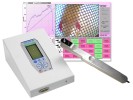Authors
JR Bumgarner, WH Walker II, JA Liu et al
Lab
Department of Neuroscience, Rockefeller Neuroscience Institute, West Virginia University, Morgantown, WV, USA
Journal
Neuroscience
Abstract
The growing presence of artificial lighting across the globe presents a number of challenges to human and ecological health despite its societal benefits. Exposure to artificial light at night, a seemingly innocuous aspect of modern life, disrupts behavior and physiological functions. Specifically, light at night induces neuroinflammation, which is implicated in neuropathic and nociceptive pain states, including hyperalgesia and allodynia. Because of its influence on neuroinflammation, we investigated the effects of dim light at night exposure on pain responsiveness in male mice. In this study, mice exposed to four days of dim (5_lux) light at night exhibited cold hyperalgesia. Further, after 28_days of exposure, mice exhibited both cold hyperalgesia and mechanical allodynia. No heat/hot hyperalgesia was observed in this experiment. Altered nociception in mice exposed to dim light at night was concurrent with upregulated interleukin-6 and nerve growth factor mRNA expression in the medulla and elevated micro-opioid receptor mRNA expression in the periaqueductal gray region of the brain. The current results support the relationship between disrupted circadian rhythms and altered pain sensitivity. In summary, we observed that dim light at night induces cold hyperalgesia and mechanical allodynia, potentially through elevated neuroinflammation and dysregulation of the endogenous opioid system.
BIOSEB Instruments Used:
Electronic Von Frey 4 (BIO-EVF4),Electronic Von Frey 5 with embedded camera (BIO-EVF5)

 Pain - Thermal Allodynia / Hyperalgesia
Pain - Thermal Allodynia / Hyperalgesia Pain - Spontaneous Pain - Postural Deficit
Pain - Spontaneous Pain - Postural Deficit Pain - Mechanical Allodynia / Hyperalgesia
Pain - Mechanical Allodynia / Hyperalgesia Learning/Memory - Attention - Addiction
Learning/Memory - Attention - Addiction Physiology & Respiratory Research
Physiology & Respiratory Research
 Pain
Pain Central Nervous System (CNS)
Central Nervous System (CNS) Neurodegeneration
Neurodegeneration Sensory system
Sensory system Motor control
Motor control Mood Disorders
Mood Disorders Other disorders
Other disorders Muscular system
Muscular system Joints
Joints Metabolism
Metabolism Cross-disciplinary subjects
Cross-disciplinary subjects Preclinical studies and opioids: role in crisis management in the United States
Preclinical studies and opioids: role in crisis management in the United States 
